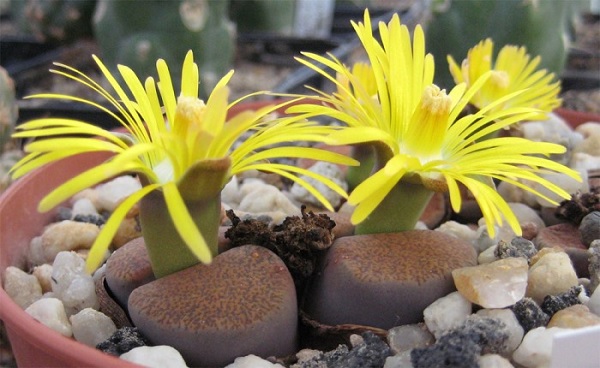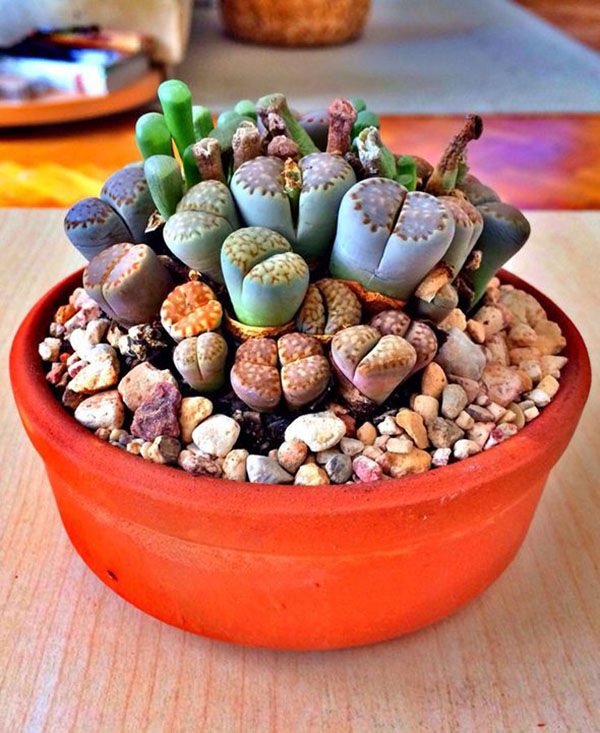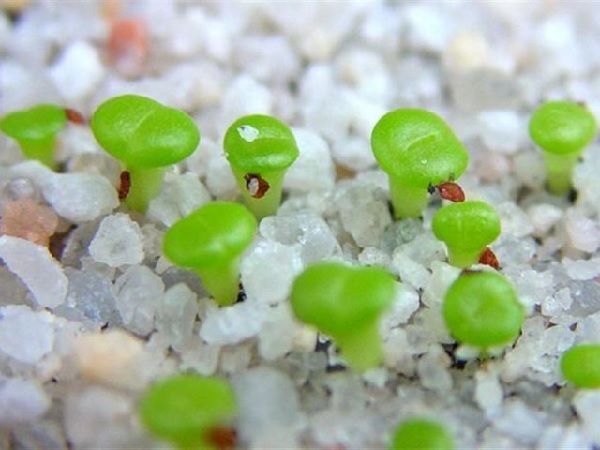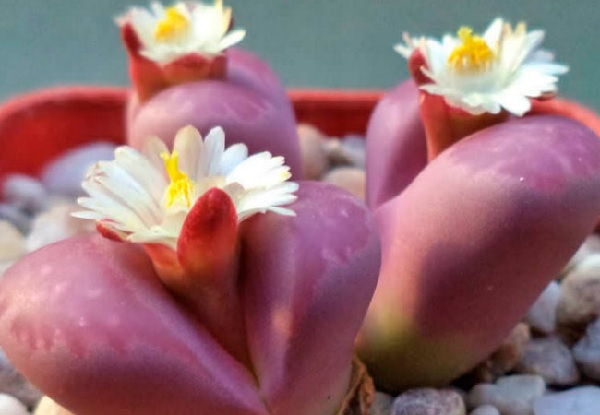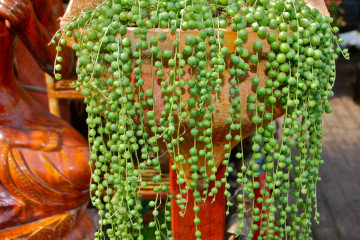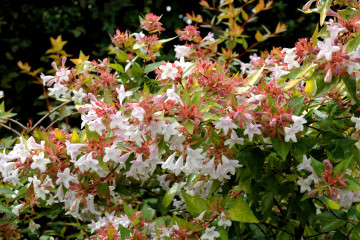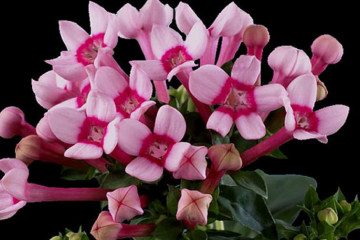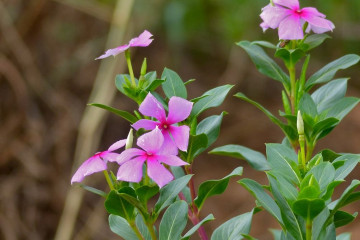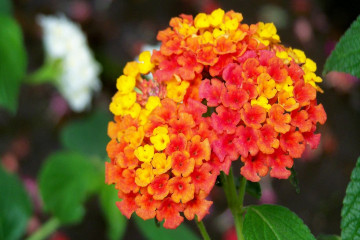Lithops: home care and breeding methods
Content:
Lithops are plants that are often referred to as "living stones". Indeed, in their appearance they resemble colored stones - this was important for their survival in desert conditions. Actually, the very name "lithops" comes from two Greek words that can be translated as "like a stone." But these plants were discovered only in 1811, when nature researcher William Barchell discovered the first plant of this type in South Africa. In Europe, they appeared only in the next century. Since then, lithops succulents have taken root as indoor flowers, but there is still not much literature on their cultivation.
What does lithops look like, what family does it belong to?
Many amateur flower growers who are going to grow lithops are interested in home care first of all. However, first you need to understand the theory of the issue.
Lithops - plants that look like stones belong to the Mesembriantem family. For most non-specialists, this still does not mean anything, so it is important to note that lithops are succulents, that is, "living stones", and are a ground cover variety of these plants. In the wild, they are common in sandy and rocky deserts. Moreover, their habitat is South Africa, Namibia and Botswana. This is how the cactus and the "living stone" differ from each other.
The aerial part of the Lithops succulent plant is one or more pairs of leaves grown together with each other, rather fleshy and juicy. They form a kind of body, which resembles a stone, and in some species, rather, a mushroom without a cap.
Despite being camouflaged, a plant like Lithops can have very interesting flowers. It is curious that this succulent rarely blooms alone. But a group of plants, and even planted in one pot or container, gives flowers much more often. It is difficult to describe them, since they can differ greatly from species to species. Their petals are most often white (sometimes with a pinkish tint) or yellow. Orange specimens are much less common.
It is important to remember one feature of the plant, which affects the conditions of its maintenance and the choice of the pot - it develops lateral buds, therefore, instead of one pair of new leaves in favorable conditions, two can form at once. At the same time, any formation consisting of a pair of leaves can again produce two plants at once, so that after a while a whole colony of such "pebbles" can form in the container.
In addition, unlike other types of succulents, in most of these plants the width and height of a pair of leaves, called the body, does not exceed 5 cm. And the furrow between them is rarely deep.
Common varieties
Today many lithops are described, species are classified.At home, not all of them are bred, but only the most unpretentious and beautiful. For example, growers who are going to grow this type of succulents may pay attention to several types described below.
Lithops beautiful
This variety is distinguished by a rather large body, the height of which reaches 5 cm. The color of the "stone" part is brownish-yellow, the pattern on it has an even darker shade. There is a rather deep crevice between the leaves. The top side is convex. On this body, large, up to 5 cm in diameter, white flowers with a pronounced delicate aroma can bloom,
Lithops marble
It has a gray-green body, but the pattern on it has a lighter shade, which resembles the pattern on the surface of natural marble. The diameter of a pair of leaves is up to 2 cm. The top is not as round as in the previous species, but it cannot be called flat either. The flower is also similar in appearance to the one described above, but it is smaller - up to 3 cm in diameter.
Lithops Aucamp
This is a species that grows in South Africa, in the Cape region. It was named after Juanita Aucamp, who discovered these plants on her father's farm in the 20th century. Its color is dominated by rusty-brown tones, although there are specimens of a green or bluish-gray shade. Its flowers are yellow, reaching a diameter of 4 cm. There are many varieties of this particular variety, for example, Betty's Beryl, Hikoruby and others, but mostly they are collected only by experienced collectors.
Fuller... This species looks interesting and even a little alien. His body is always wider than in height. As for the color, it can be from bluish-gray to brownish-yellow with a green pattern, often the surface is covered with red dots.
Although the cactus and lithops are similar, there is actually a significant difference between them. The "living stone" does not have thorns that would provide it with additional protection.
Features of home care
"Living stones" lithops are good because they are quite unpretentious. Although they are native to South Africa, their region is characterized by the changing seasons. Compared to the Northern Hemisphere, everything seems to be the opposite - winter and summer change places. But plants respond to ambient temperatures and daylight hours, not calendar dates. So it is quite easy for lithops to provide care. The main thing is to follow a few basic rules.
Temperature
Although in natural conditions these plants can withstand high temperatures, this does not mean that they need to provide the same heat at home, especially since they will look lethargic and, if I may say so, apathetic. Special conditions are needed only during the dormant period, which in the Northern Hemisphere lasts from January to March. Then the optimum temperature is + 12-14 ° C. Although these plants can even withstand frost, you should not leave them on an unheated balcony for a long time.
Lighting
This is a very light-loving plant. It is best to plant it where it will receive stable lighting. But at the same time, it is still not worth leaving it in direct sunlight for a long time, especially in summer - then you need to shade it at least for a short time.
Watering
Novice florists are always interested in the question of how to properly water lithops, because under natural conditions they grow in the desert, and therefore, for many weeks they may not receive moisture at all. In fact, the answer to it always depends on the period of development of the succulent, lithops are no exception. So, during the dormant period, watering is not done at all.
During the growth period, which occurs in April-June, the plants need to be watered carefully in order to prevent root decay. It is best to do so that the water falls only on the soil around the plant, but not on the succulent itself.
It is especially important to ensure that there is no liquid in the crevice between the leaves. But the drops should not remain on the surface either, otherwise on a sunny day they will work as lenses, and then a burn will form on the plant's body.
Humidity
During the dormant period, the plant needs dry air. During the rest of the months, moderate air humidity will create optimal conditions.
Priming
Although these plants do well in almost any earthen mixture, the soil is still important for them. The best option is considered to be a soil mixture specially designed for succulents. Other options will work, but remember that the substrate must pass water well. The fact is that lithops, especially if they have not yet had time to strengthen their roots well, are prone to rotting even with a short break. So drainage is very important.
You can plant plants alone, with families or create mixes - it will be easy to take care of it in any case.
Top dressing
This flower practically does not need feeding. But for more abundant flowering, you can use fertilizers designed for cacti.
When and how it blooms
The flowering process of these plants can look quite impressive. When they get ready to bloom, the cleft between the leaves begins to grow in size. Sometimes it happens literally before our eyes. Then a "tongue" appears from it - this is a sepal, it develops into a real flower in an average of two weeks from the moment of its first appearance.
Flowering period
It begins in late summer in most species, which is why it is so important to provide good lighting in August. However, there are plants with a later flowering period, which falls on the second half of autumn. Interestingly, almost all species bloom by noon. In general, the flowering period of this plant lasts about a week, after which the succulents turn into stones again.
Reproduction methods
There are two main ways of reproduction of lithops - by seeds and by cuttings of shoots. Traditionally, the second option is considered the simplest. However, some experts believe that only growing lithops from seeds at home will help you better understand them and get the most beautiful specimens.
Germinating seeds
The lithops seed remains viable for a very long time. Several studies have shown that seeds can germinate even after 20 years if stored in a dry place.
But most often they are removed from there and dried on a paper napkin. You can sow these plants at any time of the year, but best of all, taking into account the natural characteristics of development.
The step-by-step algorithm will be similar to germinating any other seeds:
- small plastic containers are taken for sowing,
- fill the pots with succulent substrate, only more carefully sifted than usual,
- the seeds are distributed evenly over the surface of the substrate,
- sprinkle them with a thin layer of the same earth,
- cover the pots with plastic wrap to make a small greenhouse.
Lithops from seeds are not difficult to grow. Once every two days, the described crops should be "ventilated" by opening the film and lightly sprayed with water. If the plant feels well, then its leaves will be smooth. Regardless of the variety, they will have a darker or brownish hue. Too soft and bright green leaves indicate the weakness of the "living stone".
Plant transplant
If planting a plant is a serious matter, then transplanting is extremely rare. Living stones have been doing great in the same container for many years. This is done only if fresh soil is needed, because the old soil is already depleted and the plant has stopped blooming, and also when the lithops grow strongly and begin to rise above the level of the container.
In such cases, the plant is literally shaken out of its old pot, but only very carefully. The roots are freed from the soil mixture, the dried parts are cut off. Immediately you need to check the flower for the presence of pests. Meanwhile, a drainage layer is poured into a new pot on the bottom, and prepared soil is on top. Then the lithops begin to be lowered into a new container, while holding it with one hand, and with the other, gently filling the roots with an earthen mixture. It is important that it lays down in an even layer. From above, the surface can be decorated with a layer of decorative sand. Like other succulents, the flower cannot be watered immediately after transplanting.
If you follow the basic rules of cultivation, then lithops can become a real companion plant that will live in the house for several decades, pleasing the eye with perfection and elegance of forms.

